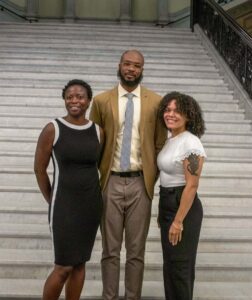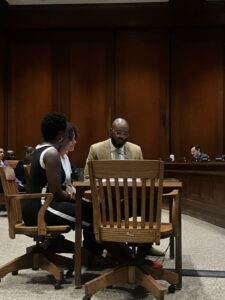Good afternoon, Chair Lewis, Chair Garlick, and distinguished members of the committee. My name is Teron Brown. I am an 8th grade math teacher at Springfield Preparatory Charter School – a charter public school in Springfield serving students in grades K-8. I am here today to testify in support of H.549 & S.311, An Act Relative to Educator Diversity.

The issue of educator diversity in our public schools is personal for me. Growing up, over the entirety of my K-12 student experience, I had just two teachers who looked like me and shared similar lived experiences to my own. Prior to these teachers taking me under their wing, I often felt disconnected and out of place at school. These teachers served as role models who inspired me and encouraged me to strive for the highest levels of achievement. Because I felt seen, I began to feel safe at school – my educational trajectory was radically transformed.
Representation matters.
Next school year marks my 18th school year of teaching. I am deeply committed to creating a safe, culturally-affirming classroom environment for all of my students. Our students deserve to see themselves reflected in the school’s priorities, staff, and curriculum. Representation is not just about visual cues; it is about fostering a deep understanding of students’ experiences and cultural backgrounds. Each year, I see the impact of this on students – our students thrive when we affirm their identities.
The impact of representation is beyond anecdotal. Research provides clear evidence of the long-term impact that teachers of color have on the academic trajectory of our students. A study out of the National Bureau of Economic Research found that Black students who had one Black teacher by the third grade were 13% more likely to go to college. Black students who had two Black teachers by third grade were 32% more likely.

We have over 71,000 Black students enrolled in public schools across Massachusetts. Yet, under 3% of public school teachers in Massachusetts identify as Black. 10% identify more broadly as people of color. By comparison nearly half of our public school students across the state identify as students of color.
The Educator Diversity Act holds tremendous potential to address this long-standing issue of underrepresentation. This legislation addresses common barriers to recruiting and retaining educators of color by creating alternative pathways to teacher licensure among other things.
By fostering an inclusive and diverse teaching workforce, we can reshape the trajectory of countless lives. I sincerely hope you will support this important piece of legislation.
Thank you.
 Back To MCPSA News
Back To MCPSA News
